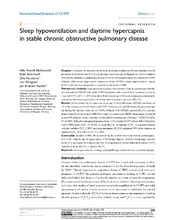| dc.description.abstract | Purpose: To explore the associations between sleep hypoventilation (SH) and daytime arterial pressures of carbon dioxide (PaCO2), sleep stages, and sleep apneas/hypopneas (AHI) in subjects with chronic obstructive pulmonary disease (COPD). SH has previously been found in COPD-subjects with chronic hypercapnic respiratory failure (CHRF) using supplementary oxygen (LTOT), and has been proposed as a possible predictor for CHRF. Patients and methods: A prospectively designed observational study in a pulmonary rehabilitation hospital of 100 (39 male) stable COPD inpatients with a mean forced expiratory volume in 1 second (FEV1) of 1.1 L (42% of predicted) and a mean age of 64 years, using polysomnography with transcutaneous measurement of carbon dioxide pressure increase (ΔPtcCO2). Results: SH as defined by the American Academy of Sleep Medicine (AASM) was found in 15 of the subjects, seven of whom used LTOT. However, six had SH despite being normocapnic during the daytime (only one on LTOT). Subjects with SH had a greater ΔPtcCO2 increase from nonrapid eye movement (NREM) to rapid eye movement (REM) sleep stages compared to non-SH subjects (mean [standard deviation] between-groups difference =0.23(0.20) kPa, P<0.0005). Subjects with apnea/hypopnea index ≥ 15 (overlap, N=27) did not differ from those with COPD alone (AHI <5, N=25) in sleep ΔPtcCO2 or daytime PaCO2. A regression model with the variables FEV1, LTOT, and sleep maximum ΔPtcCO2 explained 56% of the variance in daytime PaCO2 (F(3, 94) =40.37, P<0.001). Conclusion: In stable COPD, SH as defined by the AASM was found both in normocapnic, non-LTOT subjects and in hypercapnic, LTOT-using subjects. Between-sleep-stage increase in ΔPtcCO2 was higher in subjects with SH. Overlap subjects did not differ from simple COPD subjects in sleep ΔPtcCO2 or daytime PaCO2. | en_US |

